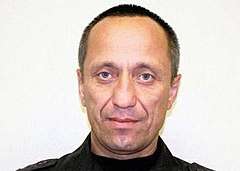Mikhail Popkov
| Mikhail Popkov | |
|---|---|
 | |
| Born |
Mikhail Viktorovich Popkov 7 March 1964 Angarsk, USSR |
| Other names |
The Werewolf The Angarsk maniac |
| Criminal penalty | Life imprisonment |
| Details | |
| Victims | 22–81 |
Span of crimes | 1992–2010 |
| Country | Russia |
| State(s) |
Angarsk Irkutsk Vladivostok |
Date apprehended | 2012 |
Mikhail Viktorovich Popkov (Russian: Михаи́л Ви́кторович Попко́в; born 7 March 1964) is a Russian serial killer and rapist who sexually assaulted and murdered numerous young women between 1992 and 2010 in Angarsk, Irkutsk, and Vladivostok in Siberia. Known as "The Werewolf" and the "Angarsk maniac"—termed as one of Russia's most prolific serial killers—for the brutal nature of his crimes, Popkov was convicted of 22 murders in 2015 and confessed to 59 additional homicides three years later. The killings, if confirmed, supersede that of the country's most notorious serial killer Andrei Chikatilo.
Life
Mikhail Popkov was born in Angarsk on 7 March 1964. Little is known about his upbringing and personal life beyond that he is married and has one daughter. He worked as a police officer in the Irkutsk region, and by the time of his capture had also spent time as a security guard at the Angarsk Oil and Chemical Company, as well as at a private firm.[1]
Popkov's crimes were motivated by suspicions that his wife had committed adultery.[2] Most, if not all, his victims were prostitutes or inebriated young women—people who Popkov considered immoral—between the ages of 17 and 38.[2] At various points between 1992 and 2010 in Angarsk, Irkutsk, and Vladivostok—a distance of some 3,900 km (2,423 mi)—Popkov, dressed in his police uniform, lured victims with the promise of a free ride and sexually assaulted them.[2] He killed women with various instruments—knives, axes, baseball bats, screwdrivers—and mutilated the bodies so grotesquely that Russian media ascribed the crimes to "The Werewolf" and the "Angarsk maniac".[3][4]
Russian police were involved in the search for one perpetrator as slain women were discovered in the mid-1990s, killed by similar methods. Despite extensive inquiries and testimonies from surviving victims, Popkov eluded police for two decades.[2] However, investigators discovered a pattern: tracks from a LADA 4x4, an off-road vehicle used by law enforcement, were found at numerous crime scenes.[5] DNA testings of 3,500 current and former policemen in Irkutsk in 2012 facilitated Popkov's capture that same year. In January 2015, he was sentenced to life in prison for 22 murders and two attempted murders.[6] Two years later, Popkov confessed to 59 additional killings, a total count which, if confirmed, supersedes infamous Russian serial killers Andrei Chikatilo and Alexander Pichushkin.[7]
References
- ↑ Thomas, Emily (6 November 2013). "Ex-Policeman, Mikhail Popkov, Allegedly Confesses To Gruesome Murdering 24 Women In Siberia". HuffPost. Retrieved 18 January 2018.
- 1 2 3 4 "'Werewolf' is worst-ever serial killer in former USSR as he is charged with killing 47 more women". Siberian Times. 11 January 2017. Archived from the original on 19 January 2018. Retrieved 18 January 2018.
- ↑ "Ex-policeman nicknamed 'werewolf' confesses to murdering 24 women in Siberia". Siberian Times. 6 November 2013. Archived from the original on 19 January 2018. Retrieved 18 January 2018.
- ↑ Rojas, Nicole (10 January 2018). "'Werewolf' serial killer Mikhail Popkov heads to trial for 59 more murders". International Business Times. Archived from the original on 19 January 2018. Retrieved 18 January 2018.
- ↑ Barbash, Fred (12 January 2018). "'Werewolf' of Siberia ranked among worst serial killers ever after confessing to 81 victims, says Russian media". Washington Post. Archived from the original on 19 January 2018. Retrieved 18 January 2018.
- ↑ "Russia's deadliest serial killer? Cop-turned-slasher faces 60 new murder charges, death toll at 82". RT. 27 March 2017. Archived from the original on 19 January 2018. Retrieved 18 January 2018.
- ↑ "Mikhail Popkov, Russian ex-cop, on trial for 59 murders". BBC. 10 January 2018. Archived from the original on 14 January 2018. Retrieved 18 January 2018.